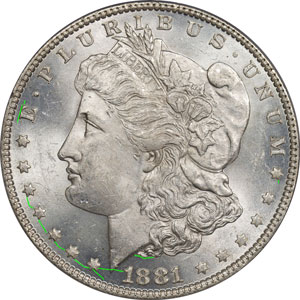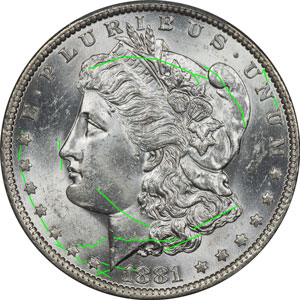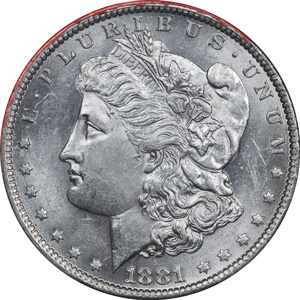
June 2018 - Welcome
Sources
Search
Contact
Home
Welcome
Click on year to expand
2022
2021
2020
2019
2018
2017
2016
2015
Welcome
Vendication - Maybe
![]() VSS Submissions
VSS Submissions
We now have all l our coins back from VSS with images and we are adding them to the web site now. We have been a little slower than normal but will be caught up this month. Then we are on to more submissions.
Our goal of 1,000 coins in our study group is basically done on the acquisition side. Actually we have 1,064 but they are not all graded and VAMed. But we will get there in the coming months.
There is one coin in the first submission that will need LVA examination when possible.
Die Fingerprints
Our Last Look at This Sequence (Maybe)
This is our continuing look at VAMs 1H, 1J, 1K, 40, and 20. Of particular interest has been the emission sequence, die cracks, and this month a look to see what physical characteristics would prove that this is the same physical die. What we cannot confirm yet is that there are no others in the sequence.
These five VAMs also have three different die designations (1, 27, and 12) which may or may not be deserved.
We have continued the discussion and repeated the analysis to date at the bottom of this page.
The Second Trick
For better or worse, while waiting on the coins from PCGS we opened up a new study outside the Morgan Dollar world. Right now we are working to secure the remaining copyright approvals, but this is timing only.
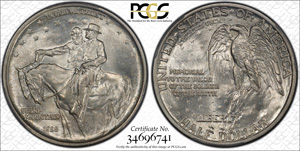
So why am I delving into in this other study? Well as a child I used to ride by the Stone Mountain Memorial with my father on trips to Atlanta. Neither of us thought it would ever be completed because of the repeated failures and just the magnitude of the task. Obviously we were wrong and the Stone Mountain Commemorative Half has always had some interest in my collecting arena.
This is a big study with some discoveries about the process and the coin, and I will post a link here and on VAMworld when it is up and going.
Since I started this web site I have had more than one occasion where I thought I had located a set of double denticles on coins. I learned a lot about ejection errors and what those look like and I believe was told repeatedly that no verifiable example of true double denticles has ever been located. Well a funny thing happened on the way to the current analysis a the bottom of this page. I was checking for details on coins to find links and suddenly realized that on a VAM 1H I was staring at a set of doubled denticles.
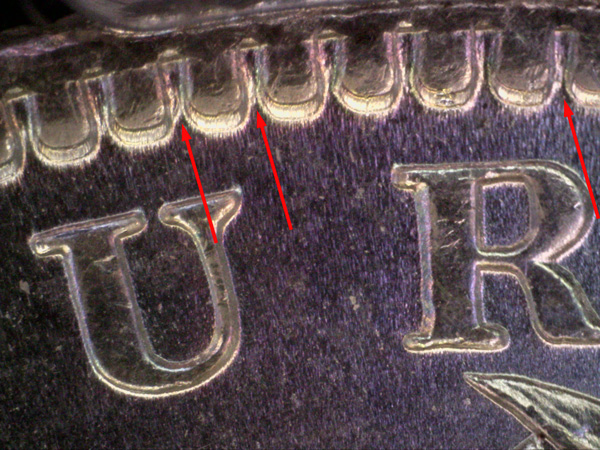
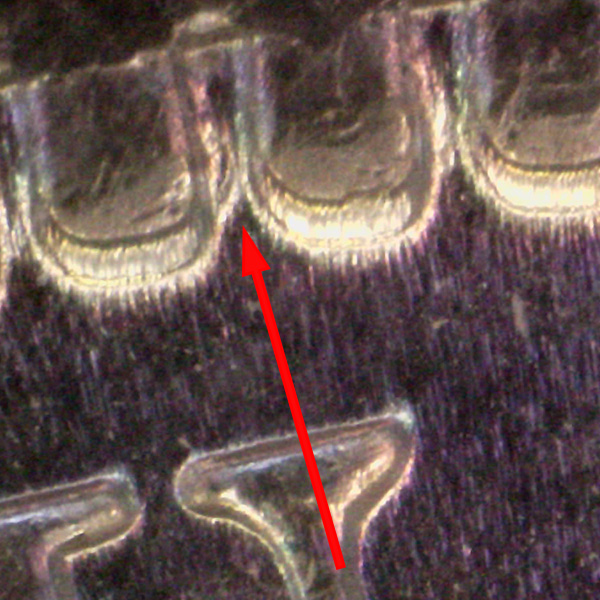
They spanned almost the top twenty-five percent of the coin, but I also realized that I needed confirmation. I learned in the die work that VAMs 40 and 1H share a die in the same state and as luck would have it these are two of our most common VAMs. We have nineteen mint state VAM 40's, and seven mint state VAM 1H's. So there was plenty of material to work with, and there they were. All twenty-six coins have the same denticle doubling in exactly the same placement. They don't photograph well, but I am learning with my microscope and can probably do more images later.
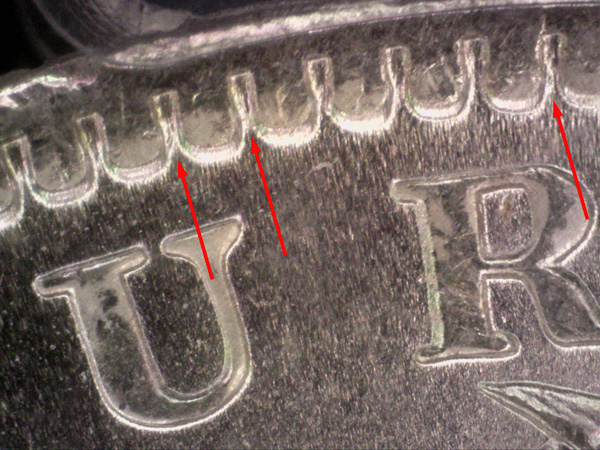
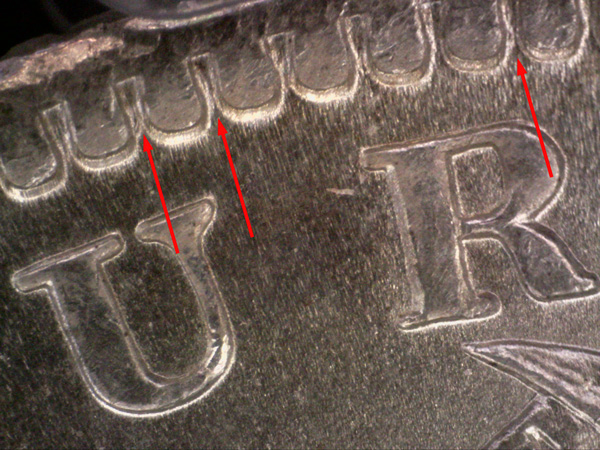
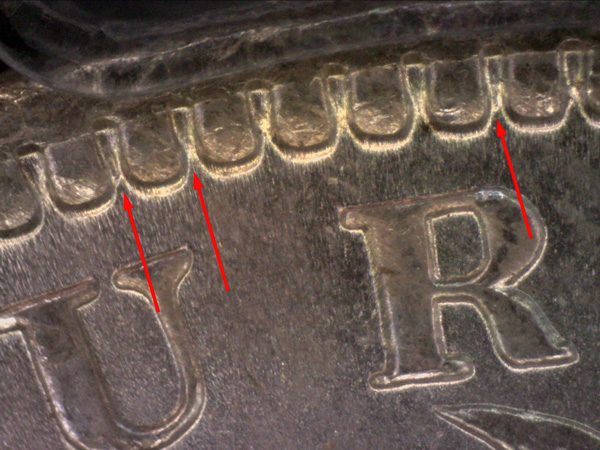
Morgan Dollar "Fingerprints"
Obverse Die 1 (VAM 1H)
Obverse Die 1 (VAM 1K)
Obverse Die 27 (VAM 40)
This Obverse Die 1 is associated with many VAMs, but two of them are of particular interest. First is VAM 1H - Die Gouges Inner Wing #2. We have many examples of this VAM for study so a lot to work with.

As listed this die shows the same physical die cracks and characteristics as VAM 40 but the progression of the die cracks just isn't as far along.
![]()
The hair curls show the same loss of detail as VAM 40.
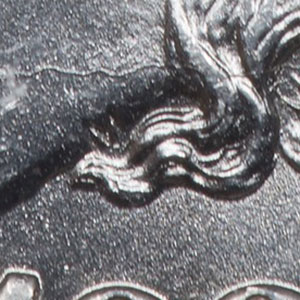
Since dies lose detail from the field forward the termination of these curls looks to be from a die that was repolished.
Obverse Die 1 (VAM 1J)
Obverse Die 1 is associated with many VAMs, but two of them are of particular interest. One of those is VAM 1J - Overpolished Reverse.
Unfortunately we have only one coin and it is an Almost Uncirculated 58, so a few of the die cracks were not as visible as on the others. Die cracks that appear on the high points of devices will for sure wear away quickly and might not appear here.
This is also an earlier use of the die than VAM 40.
![]()
But we want to make another observation that I always enjoy.
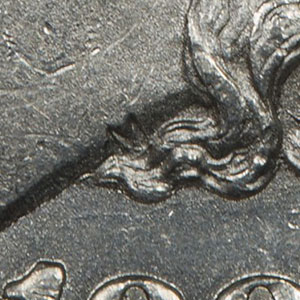
Since dies lose detail from the field forward the termination of these curls look to be from a die that has not been repolished and is relatively fresh.
Obverse Die 1 when paired with a specific Reverse Die a forms a clashed version of both the obverse and reverse dies and receives the designation of VAM 1K.
We lack an example of a VAM 1K - Clashed n and st so this link is to VAMworld.
Our observation from the discovery coin is that the die cracks that start with the left stars and then extend down through the neck and on into the date are there. The VAMworld coin is also a circulated coin in the Fine range. So any additional die cracks on the higher points of the face or hair would have quickly disappeared and we don't know if they were present.
![]()
The termination of the hair curls on VAM 1K also appear to be full or nearly full. This is a feature that is very low in the relief, so wear does not effect it until you get way down in grades.
The VAMworld coin is in Fine condition and at that stage only the tops of the hair curls are worn away.
Obverse Die 12 (VAM 20)
Obverse Die 12 when paired with a specific Reverse Die a forms VAM 20 - Doubled 18. We have several examples of VAM 20 for study, so there is lots of material in different grades.
The die crack pattern appears to be identical to the others, just not as advanced.
![]()
The termination of the hair curls on VAM 20 is nearly identical to VAMs 1J and 1K, so there was no repolishing before the reverse die was changed (if it was).
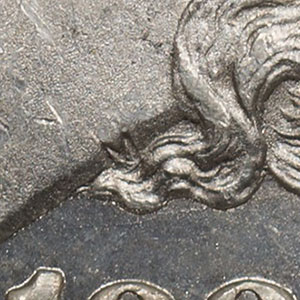
Obverse Die 27 is associated with only VAM 40 - Doubled Ear Inside and Bottom. We have several VAM 40 coins, 21 as of this analysis, and they range from Good 04 to Mint State 64. These images are from a Mint State 64 coin.
Die 27 has a number of cracked areas, several that are internal to the device that distinguish it from others. But one clincher is the unique vertical die crack above and below the nose.
![]()
We checked this feature on several VAM 40 coins and it is consistent. This die appears to have been repolished and there is a deterioration of the curls down at the field level.
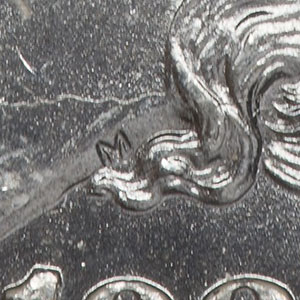
This termination is the same as with VAM 1H.
The Emission Sequence
Emission sequences are new for us and therefore we need verification of this work. But we see a clear delineation of the die use into before and after the repolishing, with VAMs 20, 1J, and 1K coming first and in that order. Then we believe the die was pulled from service and polished to try and save it, put back in service only to have it fail again. On that second round the sequence of use was VAMs 40 and then 1H. It is possible that VAM 1I is in this sequence but we need more evidence to confirm that addition.
Just One Die?
Right now these five VAMs have three different obverse die designations. VAMs 1H, 1J, and 1K are all designated as Obverse Die 1. VAM 20 has a die designation of 12, and VAM 40 has a die designation of 27. However, one of the challenges with VAMing can be having all the coins in the same place at the same time to compare features. In this case we can do an 80% comparison on typical features to see why these VAMs have different die designations and are they correct. And we are sure we can get a little help with VAM 1K once we work with these four.
Methodology
LIBERTY Headband
Mouth
To try and determine if all three VAMs came from the same physical die we decided to examine two of our highest graded coins for each VAM. In the Case of VAM 1J we have only one example, and with VAM 1K we unfortunately have none. But we will fill these in over time.
The coins we examined are:
VAM 20 - Doubled 18
82490315 - MS 60
19925080 - MS 62
84368570 - AU 58
VAM 1H - Die Gouges Inner Wing #2
31810490 - MS 62
25655639 - MS 65
VAM 40 - Doubled Ear Inside and Bottom
24909742 - MS 64
81802246 - MS 64
What We Examined
To try and determine if the dies used were in fact the same we examined three areas other than die crack similarity that we consider unique, one of which may be a surprise.
The obverse features included the inner ear, the LIBERTY Headband, and the mouth. Please keep in mind we are only looking for similarities in the Obverse Dies.
Also, please keep in mind that we believe the emission sequence is 20, 1J, 1K, 1H, AND 40. so there should be differences, but progressive differences.
Inner Ear
Looking at these photographs it seems apparent that the inner ear matches with VAM's 20 and 1J, and also matches for VAM's 1H and 40. The earlobe could be a match for all four.
VAM 20
There are two features of note on coin 19925080 and these are two horizontal lines on the inner ear and a small doubling of the earlobe. The inner ear lines are only present on this coin, but the other is an MS60 and the strike might not be full in this area.
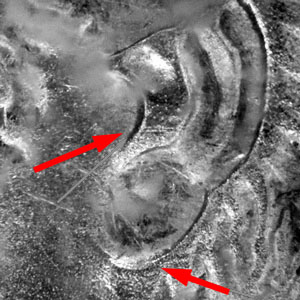
VAM 1J
VAM 1J also has the same die scratches on the inner ear and the same doubling of the earlobe. This is coin 84368570, an AU58 example. This is our only example of VAM 1J.
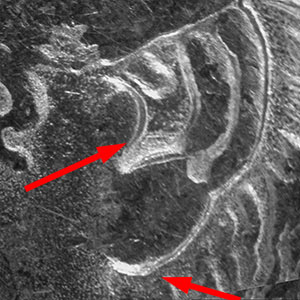
VAM 1H
VAM 1H does present a different story. The lines are not present and we believe most of the pitting has been removed from the die through polishing. But there are two little pitting marks or dots in a specific place that are identifiable. This is coin 25655639, an MS65 example.
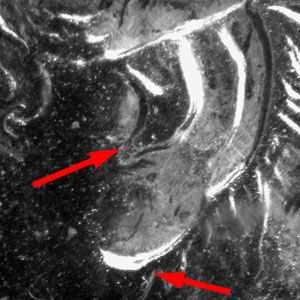
VAM 40
The images for VAM 40 match so closely to the ones for VAM 1H that they could be clones. The same two dots that are present on VAM 1H are still there, and the earlobe doubling is the same. This is an image of coin 81802246, an MS64 example.
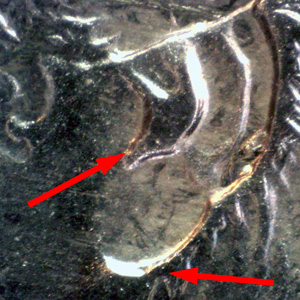
Liberty's headband is always a good place to look, so our second analysis went there.
VAM 20
When we look inside the TY there are several polishing lines that run diagonally through both letters. These are on coin 19925080.
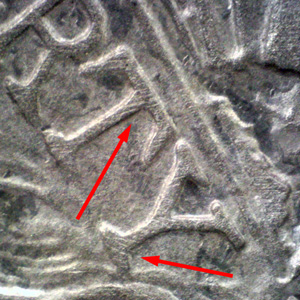
VAM 1J
VAM 1J also has the same polishing line in the TY and in this picture you can see that there is a slight bit of doubling, but it is more like what we think of as Longacre doubling where the letters are stepped down around the perimeter of the letters. The doubling is present on the VAM 20 but does not photograph well. This is coin 84368570, an AU58 example. This is our only example of VAM 1J.
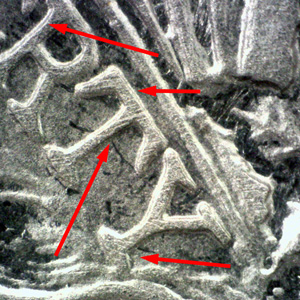
VAM 1H
VAM 1H is where we believe there is a repolishing transition, and if so then this may be a good indicator. In the TY all the polishing lines are gone except for the bottom of the Y. We cannot say that they are an exact match, but they are directionally the same. This is coin 25655639, an MS65 example.
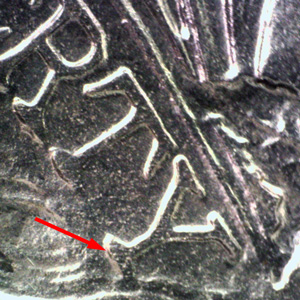
VAM 40
The images for VAM 40 match so closely to the ones for VAM 1H that they could be clones. But there are some stronger polish lines that could be the transition between 20, 1J, and then 40. If that is correct then it might be that VAM 40 came before VAM 1H in the sequence. This is an image of coin 81802246, an MS64 example.
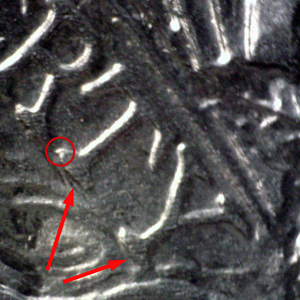
And then I had an accidental discovery that links all four VAMs. There is a chip missing out of the bottom left side of the letter T. This same chip is missing on all four VAMs. So this may further tie the four together into one physical die.
Often for us a good PUP is the clutter in the mouth. Like other features this can be unique to a die.
VAM 20
There is a bold and distinctive pair of lines toward the front of the lips. These are on coin 19925080.
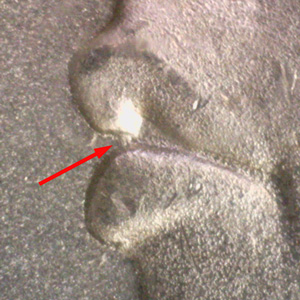
VAM 1J
VAM 1J has the same lines in the front of the mouth. This is our only example of VAM 1J.
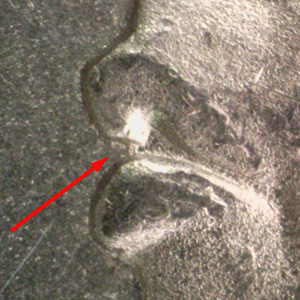
VAM 1H
VAM 1H is where we believe there is a repolishing transition. Now the lines are gone. This is coin 25655639, an MS65 example.
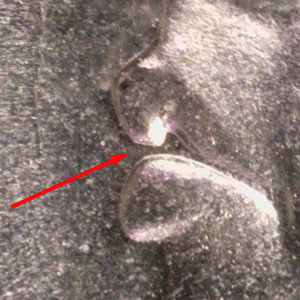
VAM 40
Like others in this analysis, the images for VAM 40 match so closely to the ones for VAM 1H that they could be clones. The lines at the front of the lips are gone. This is an image of coin 81802246, an MS64 example.
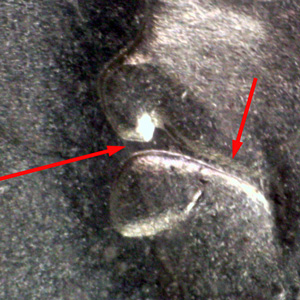
Emission Sequence Revised
We thought we had the emission sequence all nailed down as 20, 1J, 1H, and then 40. But a funny thing happened on the way to the denticle tail above. We found this coin.
Click on image for larger view
We have a significant number of VAMs 40 and 1H and we were checking the denticles for duplication. Then we ran into this coin, a VAM 1H and it has extensive rim damage that we do not believe the die could have recovered from and gone back into service. So we need to assume that use of the die ended with VAM 1H.
With all this in mind we think the correct sequence is 20, 1J, 40, and 1H. 1K probably fits in there somewhere but that will need to come later when we acquire one.
Getting Started
Collecting The 1881-O
The 1881-O VAMs






















